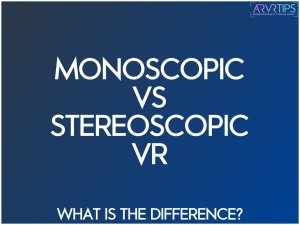People new to the industry often struggle with differentiating between different types of VR. Specifically, they often don’t understand what’s the difference when doing a monoscopic vs stereoscopic VR comparison.
How does each one work?
Which one is better?
What benefits and features do choosing one over the other bring to VR developers and users? This blog explores all that and more in detail.
The Detailed Monoscopic vs Stereoscopic VR Comparison
A monoscopic VR environment is one that was created with a single camera lens or a bunch of lenses arranged in a rig or ring. This type of VR projects a single 360-degree image to the user’s eyes. Also known as 2D VR content, monoscopic VR can appear flat and less realistic. However, it is still popular with users and developers and looks pretty good on a mobile screen or a VR headset.
You can buy any 360 degree camera and begin shooting monoscopic VR videos today.
By comparison, stereoscopic VR content is far more immersive and realistic. This is because when recording the VR environment, developers make use of two images instead of one. Stereoscopic VR is based on the fact that people’s left and right eyes have different perspectives. This type of VR has one image for each eye, making for a richer and more realistic experience. It is also known as 3D VR content since it has a much better sense of depth than flatter 2D monoscopic VR content.
Usability and Versatility
Monoscopic vs stereoscopic VR technology both help developers create 360-degree immersive experiences. It is possible to view both monoscopic and stereoscopic VR content on a VR headset. Of course, the difference in immersion quality will be obvious.
But one advantage monoscopic content has in terms of viewability is that you can watch 360 videos on a smartphone as well. You can’t do the same for stereoscopic content.
On the other hand, it is very likely that most of the VR content you have seen on headsets is stereoscopic 3D VR content. Thanks to superior depth perception, stereoscopic content offers a more realistic experience and better immersion.
It remains the format of choice for most VR developers when creating high-quality 360-degree environments for VR headsets, such as 3D VR games.
In the next section, we’ll go over the benefits of both monoscopic vs stereoscopic VR.
The Benefits of Using Monoscopic VR
Just because it has less depth perception than stereoscopic content, monoscopic VR content often gets dismissed as a basic iteration. However, people underestimate exactly how powerful a medium it can be when used in the right setting. Here’s when it could be the right option for you:
Budget-Friendly
That’s not to mention it is usually much cheaper to produce monoscopic content because it involves fewer cameras and less precision. If you’re a VR developer working on a very tight budget, this may be just the option you need. In terms of production costs, you may find it yields a cost-appropriate output, making it a popular favorite with many smaller VR teams.
Flexibility In Use
Monoscopic VR content may not have stellar depth perception, but that gives it another advantage over stereoscopic 3D content. You can watch monoscopic content on both a headset and a smartphone, but you can’t do the same with stereophonic content.
Since it only creates a single 360-degree image in 2D, monoscopic content can work easily on your average smartphone VR apps. That means you don’t need to invest in a costly VR headset or equipment to experience the content.
Use Cases In Photography
360-degree photography is a widely used phenomenon when it comes to sharing immersive images. In most cases, the 360-degree photography you see online is usually based on monoscopic content. Essentially, you can connect still images of any space together to create a version of that space in VR.
This is an extremely common medium in certain industries such as real estate, where homes hoppers can immerse themselves in a virtual apartment or house without having to go there in person.
The Benefits of Using Stereoscopic VR
Of course, after reading the section above you might be wondering why you need to look at stereoscopic VR content at all. After all, monoscopic content can get the job done for less money, and allows users to watch the content on their smartphones.
With a more versatile potential audience, you don’t just have to make content for people with VR headsets. All of this is true, but stereoscopic VR still offers significant value to developers and creators:
Much More Advanced
Yes, you will be needing a VR headset to be able to view and experience stereoscopic VR content. But that isn’t necessarily a bad thing. The VR hardware industry is growing and adapting quickly. Thanks to better technology and better processes, as well as significant demand for their products, VR companies that manufacture headsets are reporting a growth in sales.
What’s more, tech giants like Amazon, Facebook, and YouTube are investing heavily in VR tech to broaden its applications and use cases. There is significant buzz growing around VR retail experiences, entertainment, games, and much more.
Better 3D Immersion
There is a very good reason for needing to have a VR headset for this type of VR content. You can experience better, more sophisticated depth perception that wouldn’t be possible on a smartphone screen. This makes the experience much more realistic, with many opportunities to include interactive elements.
With better immersion, it is possible for brands to harness this technology to capture the attention of their audience and increase visibility. With a technology that ensures a memorable and realistic experience, it is very evident that brands will want to get on board.
Whether future VR environments will allow a customer like me to have a virtual “face-to-face” with my Spectrum Austin Support rep is not a question of if but when. It is only a matter of time before more brands start realizing the business value VR content and environments can offer.
It would be a wise move to get on the bandwagon early on and reap the first-mover advantages in your niche.
Hopefully this answers all of your questions about monoscopic vs stereoscopic VR. Comment below if you have any more!


